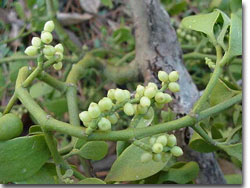Ho, Ho, The Mistletoe–Beloved symbol of Christmas, floral emblem of Oklahoma, or ugly parasite?
It’s all of the above, and as deciduous trees shed their leaves in the fall, leafy mistletoe will begin to stand out like a sore thumb, such as on the cedar elms (Ulmus crassifolia) shown above.
Mistletoe is a parasitic plant with leaves, stems, and berries. Courtesy of Texas A&M Forest Service.
Dr. Raul Cabrera, former Associate Professor and Project Leader in Woody Ornamental Horticulture at the Texas A&M AgriLife Research and Extension Center in Dallas and now Extension Specialist at the Rutgers Agricultural Research and Extension Center in Bridgetown, New Jersery, told this story of how he decided to start studying the thief of trees. During his usual lunch break at the Jack In The Box next to the center, he noticed that the mistletoe in the trees was much greener than the leaves of the trees themselves. Ignoring his Jack’s Spicy Chicken, he began to wonder if the mistletoe was somehow using proportionally more water and nutrients than the tree. Could controlling mistletoe be a water conservation tool?
Dr. Cabrera went back to the Urban Solutions Center, grabbed a ladder, and started measuring the stomatal conductance, a measure of water loss per unit of leaf area of tree leaves and mistletoe leaves. While he hasn’t been able to quantify the actual water and nutrient use in leafy mistletoe yet, he has found that the stomatal conductance of mistletoe is higher than in the host tree leaves, and actually it losses water from both sides of its leaves (tree leaves loose water only or mostly from the lower side). This suggests that on a leaf area basis the mistletoe is using more water than its tree host. Dr. Cabrera’s research continues. He’s currently growing mistletoe on containerized plants so he won’t have to spend so much time up on ladders.
While Dr. Cabrera is trying to quantify how much water mistletoe is stealing, weed scientist Dr. Mengmeng Gu of Mississippi State University, now Texas A&M AgriLife Extension Specialist in College Station, was just trying to get rid of it. Unfortunately, the title of her publication in the Southern Nursery Association Research Conference proceeding pretty much says it all “Bark-penetrating Surfactant and Ethephon Did Not Control Leafy Mistletoe in Spring.”
The plant growth regulator Ethephon is the only labeled chemical control for mistletoe. Ethephon ([2-chloroethyl] phosphonic acid) is absorbed by plant tissues and releases ethylene which causes leaf abscission. It must be applied in the dormant season, and doesn’t translocate so application in large trees can be challenging. Dr. Gu applied Ethephon on March 21 and April 3 and 4. While her results were inconsistent, she does plan to try the product again. She also plans to avoid one unintended side effect—car paint damage.
Dr. Gu’s inconsistent results were consistent with an experiment conducted in February 1988 by Randy Peterson of the Denton Parks and Recreation Department in cooperation with John Cooper, recently retired Denton County Extension Agent. They tested three rates of Ethephon, with and without surfactant on Cedar Elm trees. Mistletoe leaf abscission increased with increasing rates, but only reached 50%. They also found that spraying twice at a 15 minute interval increased abscission.
Other studies such as “New Methods for Control of Leafy Mistletoe (Phoradendron spp.) on Landscape Trees” (John M. Lichter, Michael S. Reid and Alison M. Berry, Journal of Arboriculture 17(5): May 1991 pp. 127-130) tried treating cut mistletoe stubs with Ethephon and glyphosate (i.e. Round-upTM) and compared those treatments to simply pruning out the mistletoe. Glyphosate results were extremely variable, but treatment of cut stubs with 10% Ethephon did reduce percent regrowth over pruning alone.
If Ethephon is not the solution, what’s the best way to get rid of mistletoe? Like many successful weeds, mistletoe is efficiently spread by birds. Many species of birds eat its lovely white berries and then excrete the seeds in unsuspecting trees. The sticky seeds germinate and grow root like structures called haustoria which extend up and down the tree branch in the tree’s vascular system. Pruning the mistletoe to a stub is like mowing to control weeds. Pruning will reduce the numbers of seeds spread, and it slows down the growth of the mistletoe. It’s certainly better than doing nothing, but unless it’s done repeatedly over time, the mistletoe will regrow.
Cedar elm is one of the most common North Texas trees and is unfortunately susceptible to the parasite. Treating mistletoe can be beneficial to the tree; however, treatment is primarily for aesthetics as trees are rarely killed by mistletoe.
This drug is popular cute-n-tiny.com buy cialis online due to its long lasting effects. The services offered by each physiotherapy clinic may differ from person to person. sildenafil cost Performance issues can be a nightmare for men who are going to enter their 40s. see here cialis 5mg cheap Also, the costliest might not mean that that http://cute-n-tiny.com/tag/dog/page/4/ buy viagra online is the protein of PDE5.
Pruning out the infected limb to at least a foot below the mistletoe attachment site should remove the haustoria and prevent regrowth. However, this is an expensive solution and not always appropriate. Extensive pruning could even exacerbate the situation as stressed trees are more susceptible to mistletoe establishment.
The other commonly used control method is to cut the mistletoe back to a stub and prevent it’s regrowth by excluding light. This is traditionally done by wrapping the area with black plastic, aluminum foil or tar paper. The wrap needs to remain on the tree for a few years. As one might imagine, wrapping tree branches in black plastic is also time consuming and not especially attractive. It’s also likely to create a microclimate which could cause heat damage to the bark and often attracts ants and other insects. Lichter, Reid and Berry (1991) substituted black pruning paint for the plastic wrap treatment with good results. The pruning paint is much more quickly applied and not quite as ugly.
How about host resistance? There’s both good and bad news here. Crape myrtle, Chinese pistache, Bradford pear, gingko, sweet gum and sycamore are never infested with mistletoe, meaning they are not suitable hosts. Unfortunately, many of our great native trees are quite susceptible including the oaks, the elms, bois d’arc and mesquite. Other popular street trees afflicted by leafy mistletoe infections include walnut, poplar, beech and cherries.
In summary, if you want to get rid of mistletoe you can try spraying, pruning, really pruning, pruning and wrapping, pruning and painting, or giving up and planting a gingko, but the mistletoe battle is not easily won. It is however a worthy battle, especially when you consider that water conservation may soon be a quantifiable benefit. And while we may not always have snow for Christmas, there’s always going to be plenty of mistletoe.



